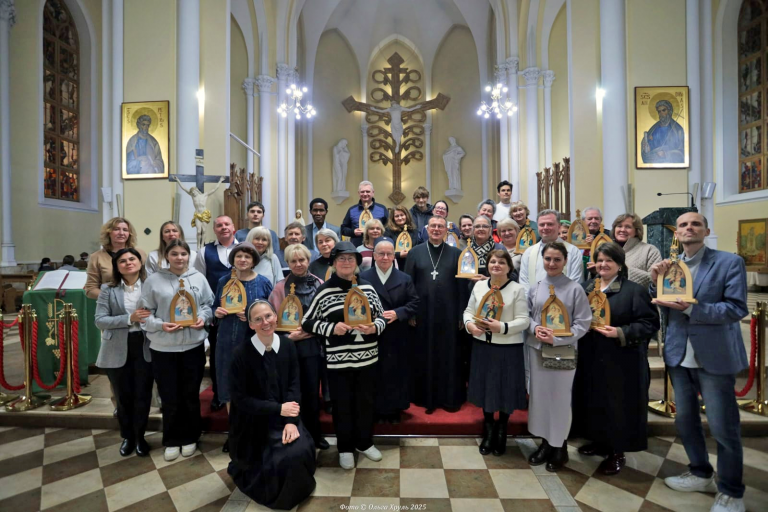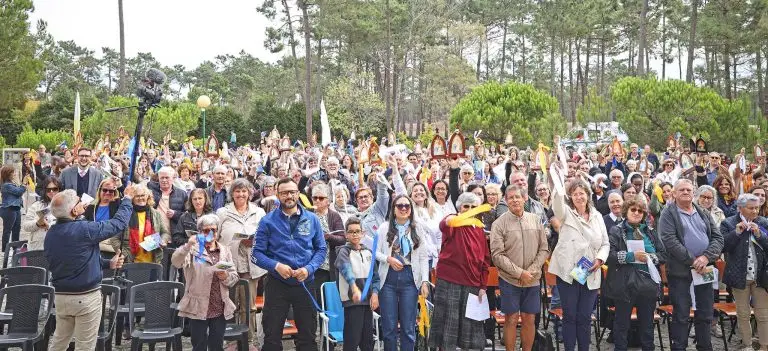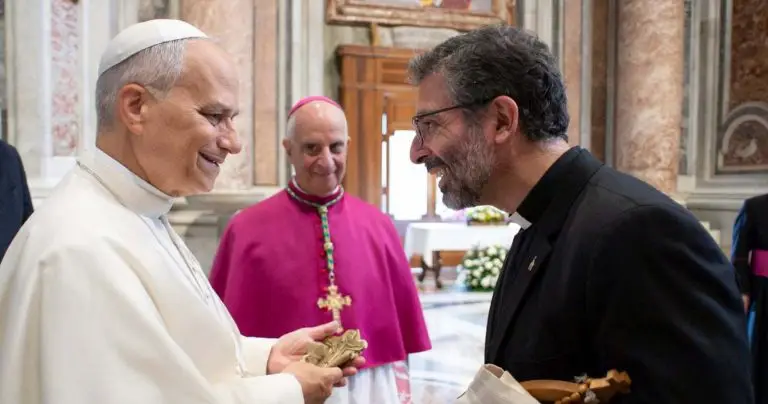Green fields, colorful flowers, and a place where it is possible to imagine João Luiz Pozzobon as a child running through the fields. This is São João do Polêsine, in the Fourth Italian Immigration Colony, where the Venerable João Pozzobon was born.
This Friday, September 13, the penultimate day of the International Congress of the Apostolate of the Pilgrim Mother of Schoenstatt, was dedicated to visiting São João do Polêsine and Ribeirão, passing through historical and symbolic places in the life of the Pozzobon family.
The extensive logistics involved 17 vehicles (including buses and minibuses) to take the 700 congress participants to the historic region, which is about 40 minutes from Santa Maria. The groups were divided into four different itineraries, all of them taking turns and passing through the same historic places where João Pozzobon was born and grew up.
The place where it all began
The Pozzobon family home, where João was born, has been rebuilt and features representations of the rooms as they were in the past, with a kitchen, furniture, utensils, etc.

A notable feature is a wayside shrine where the family used to bury the umbilical cords of newborns, including that of João Pozzobon. The chapel is shaped like an arrow pointing upwards, which also refers to the shape of the Shrine.
Analia Quijano, from Spain, is visiting this special place for the first time and comments: “I really liked the video at the end, which tells a little about his life (Pozzobon’s). That’s what I liked the most personally. And then, in the house, you realize how much space they had to grow. Living with so much space and surrounded by such beautiful countryside… It must have been very healthy, right? A place that is a paradise, really. And well, he must have been happy here. I mean, a family in a suitable place.”
The chapel where faith is built
Another symbolic place in the history of the Apostolate of the Pilgrim Virgin is the community in which João Pozzobon participated, the Chapel of St. Peter. He attended Mass on Sundays in this small church, and it was there that he received the sacraments: he was baptized, made his first communion, got married…
Throughout the day, the four groups of pilgrims took turns visiting the church, and many of them participated in Holy Mass there.
“It was really exciting to relive and feel what he felt. From the moment we arrived here, we relived everything that Pozzobon was, from a very young age: his roots, his principles. And, honestly, all of this is very moving,” says María Alejandra Vázquez, from Argentina.


Renewing the baptismal promises
Since Pozzobon was baptized in this chapel, all the congress participants were able to touch the baptismal font and bless themselves with holy water. In a later experience, outside the chapel, everyone received candles and were also able to renew their baptismal promises.
Another memorable moment was dedicated to learning about and deepening the history of the Covenant of Love Day celebration. Currently, thousands of communities in various countries around the world celebrate Covenant Day (usually on the 18th of each month). And all of this began in Santa Maria, with the encouragement of the Founder of Schoenstatt, Fr. Joseph Kentenich.
Family spirit
For lunch, the groups were divided according to historical sites. Next to St. Peter’s Chapel, several congress participants gathered in the hall and enjoyed an “impromptu show” by the Schoenstatt Fathers, who entertained and inspired everyone.
Another group gathered in San Juan del Polésine and attended a presentation of traditional dances from the region, involving the participants in the dances and entertainment.


Schoenstatt Father Sajan Paul Puthur is from India, but he works with the Movement in Mexico. He says that few members of the Mexican delegation knew about these historical sites, so “everyone is really excited.”
Fr. Sajan explains: “When visiting these places, I felt like I was reliving the memories of Deacon Pozzobon. Since I am responsible for the Pilgrim Mother Apostolate in the Monterrey region, I was happy to visit these places to learn more and be reanimated in the mission. It is not only a historical center, but above all, a memory for each one of us. Our founder also passed through here. Together with all the people of Mexico, we said: ‘How good it is that we are here.’ At that moment, some were already crying when they saw Pozzobon’s things. They were truly very moved.”


Cultural night
The evening program brought everyone together for cultural presentations in front of the Tabor Shrine. Groups from different countries presented a cantata in honor of Mary. Each nation brought typical songs, some slow and others more lively, such as the representatives from Burundi, who got everyone dancing.
“This presentation was terrific. I thought everything was so beautiful, especially the part where the children participated. It was lovely to see the difference in culture, in such different countries,” said Emilia Carvalho from Brazil.

To close the evening, Argentina’s presentation featured well-known songs that cheered everyone up. The Schoenstatt Fathers and the young people sang ”Surge Valentía“ and ”La de Siempre,” moving many who were waiting for the last presentation. Despite requests for “one more” (and due to the time), it was necessary to end with the final blessing, but with hearts on fire and the certainty that the celebration continues, as the long-awaited Spring Pilgrimage begins the next day.
Photos: Márcia Kazumi / Taciana Ferreira / Larissa Rodrigues
Translation: Sr. M. Lourdes Macías



